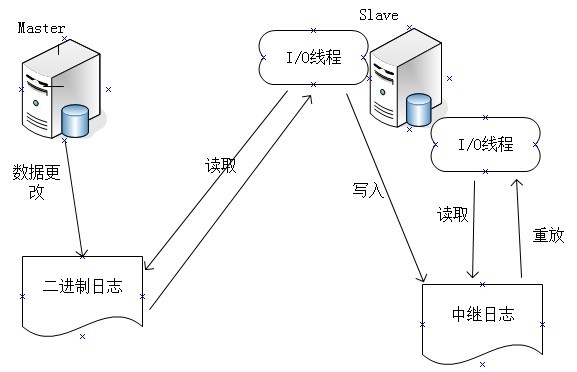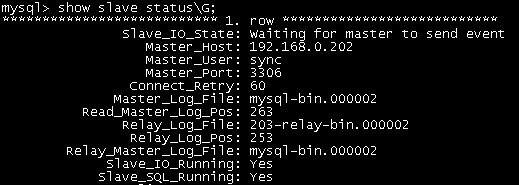The principle and configuration of MySQL master-slave replication
Working principle diagram:

Principle of master-slave replication:
It is divided into synchronous replication and asynchronous replication. Most of the actual replication architecture is asynchronous replication. The basic process of replication is as follows:
1). The IO process on the Slave connects to the Master and requests the log content from the specified position of the specified log file (or from the beginning of the log);
2). After the Master receives the request from the Slave's IO process, the IO process responsible for replication reads the log information after the specified location of the log according to the request information, and returns it to the Slave's IO process. In addition to the information contained in the log, the returned information also includes the name of the bin-log file and the location of the bin-log that the returned information has reached on the Master side;
3).Slave's IO process receives After receiving the information, add the received log content to the end of the relay-log file on the Slave side in turn, and record the file name and location of the read bin-log on the Master side into the master-info file so that it can be read next time. When retrieving it, you can clearly tell the Master "I need to start from where in a certain bin-log to log the following content, please send it to me";
4). Slave's Sql process detects relay- After new content is added to the log, the content of the relay-log will be parsed immediately to become the executable content when it is actually executed on the Master side, and executed on itself.
Environment description
Operating system: CentOS6.3_x64
Main server master: 192.168. 0.202
Slave server slave: 192.168.0.203
1. mysql master-slave replication
1. Master From the installation of mysql, the version is the same
We installed mysql-5.5.30.tar.gz, omitted here...
2. Modify the master and slave server
master服务器配置: vi /usr/local/mysql/etc/my.cnf [mysqld] server-id=202 #设置服务器唯一的id,默认是1,我们设置ip最后一段,slave设置203 log-bin=mysql-bin # 启用二进制日志 binlog-ignore-db = mysql,information_schema #忽略写入binlog的库 slave服务器配置: vi /usr/local/mysql/etc/my.cnf [mysqld] server-id=203 replicate-do-db = abc #只同步abc库 slave-skip-errors = all #忽略因复制出现的所有错误
3. Restart the master-slave server mysql
/etc/init.d/mysqld restart
4. Create an account on the master server and authorize slave
mysql> mysql -u root -p123.com mysql> GRANT REPLICATION SLAVE ON *.* to ‘sync’@‘192.168.1.2’ identified by ‘1234.com’; #replication:复制
5. Check the master database status
mysql> show master status; +------------------+----------+--------------+------------------+ | File | Position | Binlog_Do_DB | Binlog_Ignore_DB | +------------------+----------+--------------+------------------+ | mysql-bin.000002 | 263 | | | +------------------+----------+--------------+------------------+
6. Configure the slave database
mysql> change master to -> master_host='192.168.0.202', -> master_user='sync', -> master_password='1234.com', -> master_log_file='mysql-bin.000002', -> master_log_pos=263; #Log和pos是master上随机获取的。这段也可以写到my.cnf里面。
7. Start the slave synchronization process and check the status
mysql> start slave;

The values of Slave_IO_Running and Slave_SQL_Running must be YES to indicate that the status is normal.
8. Verify master-slave synchronization
Create database abc in master mysql, and then check from mysql that the synchronization has been successful!
mysql> create database abc; mysql> show databases; +--------------------+ | Database | +--------------------+ | information_schema | | abc | | mysql | | performance_schema | | test | +--------------------+
Error reported at slave startup:
"Last_IO_Error: Got fatal error 1236 from master when reading data from binary log: 'Could not find first log file name in binary log index file'"
Solution: The main reason for the error is that the binary file name or pos value set by the slave to the master does not correspond!
First flush logs; clear the logs, then check the status of the master database show master status; look at the log file name and position value;
Then in the slave, execute: CHANGE MASTER TO MASTER_LOG_FILE ='binary log name',MASTER_LOG_POS=value;
Finally start the synchronization process: start slave;
The above is the principle and configuration content of MySQL master-slave replication, please pay attention to more related content PHP Chinese website (www.php.cn)!

Hot AI Tools

Undresser.AI Undress
AI-powered app for creating realistic nude photos

AI Clothes Remover
Online AI tool for removing clothes from photos.

Undress AI Tool
Undress images for free

Clothoff.io
AI clothes remover

Video Face Swap
Swap faces in any video effortlessly with our completely free AI face swap tool!

Hot Article

Hot Tools

Notepad++7.3.1
Easy-to-use and free code editor

SublimeText3 Chinese version
Chinese version, very easy to use

Zend Studio 13.0.1
Powerful PHP integrated development environment

Dreamweaver CS6
Visual web development tools

SublimeText3 Mac version
God-level code editing software (SublimeText3)

Hot Topics
 1669
1669
 14
14
 1428
1428
 52
52
 1329
1329
 25
25
 1273
1273
 29
29
 1256
1256
 24
24
 Laravel Introduction Example
Apr 18, 2025 pm 12:45 PM
Laravel Introduction Example
Apr 18, 2025 pm 12:45 PM
Laravel is a PHP framework for easy building of web applications. It provides a range of powerful features including: Installation: Install the Laravel CLI globally with Composer and create applications in the project directory. Routing: Define the relationship between the URL and the handler in routes/web.php. View: Create a view in resources/views to render the application's interface. Database Integration: Provides out-of-the-box integration with databases such as MySQL and uses migration to create and modify tables. Model and Controller: The model represents the database entity and the controller processes HTTP requests.
 MySQL and phpMyAdmin: Core Features and Functions
Apr 22, 2025 am 12:12 AM
MySQL and phpMyAdmin: Core Features and Functions
Apr 22, 2025 am 12:12 AM
MySQL and phpMyAdmin are powerful database management tools. 1) MySQL is used to create databases and tables, and to execute DML and SQL queries. 2) phpMyAdmin provides an intuitive interface for database management, table structure management, data operations and user permission management.
 MySQL vs. Other Programming Languages: A Comparison
Apr 19, 2025 am 12:22 AM
MySQL vs. Other Programming Languages: A Comparison
Apr 19, 2025 am 12:22 AM
Compared with other programming languages, MySQL is mainly used to store and manage data, while other languages such as Python, Java, and C are used for logical processing and application development. MySQL is known for its high performance, scalability and cross-platform support, suitable for data management needs, while other languages have advantages in their respective fields such as data analytics, enterprise applications, and system programming.
 Laravel framework installation method
Apr 18, 2025 pm 12:54 PM
Laravel framework installation method
Apr 18, 2025 pm 12:54 PM
Article summary: This article provides detailed step-by-step instructions to guide readers on how to easily install the Laravel framework. Laravel is a powerful PHP framework that speeds up the development process of web applications. This tutorial covers the installation process from system requirements to configuring databases and setting up routing. By following these steps, readers can quickly and efficiently lay a solid foundation for their Laravel project.
 Explain the purpose of foreign keys in MySQL.
Apr 25, 2025 am 12:17 AM
Explain the purpose of foreign keys in MySQL.
Apr 25, 2025 am 12:17 AM
In MySQL, the function of foreign keys is to establish the relationship between tables and ensure the consistency and integrity of the data. Foreign keys maintain the effectiveness of data through reference integrity checks and cascading operations. Pay attention to performance optimization and avoid common errors when using them.
 Compare and contrast MySQL and MariaDB.
Apr 26, 2025 am 12:08 AM
Compare and contrast MySQL and MariaDB.
Apr 26, 2025 am 12:08 AM
The main difference between MySQL and MariaDB is performance, functionality and license: 1. MySQL is developed by Oracle, and MariaDB is its fork. 2. MariaDB may perform better in high load environments. 3.MariaDB provides more storage engines and functions. 4.MySQL adopts a dual license, and MariaDB is completely open source. The existing infrastructure, performance requirements, functional requirements and license costs should be taken into account when choosing.
 SQL vs. MySQL: Clarifying the Relationship Between the Two
Apr 24, 2025 am 12:02 AM
SQL vs. MySQL: Clarifying the Relationship Between the Two
Apr 24, 2025 am 12:02 AM
SQL is a standard language for managing relational databases, while MySQL is a database management system that uses SQL. SQL defines ways to interact with a database, including CRUD operations, while MySQL implements the SQL standard and provides additional features such as stored procedures and triggers.
 What software is better for yi framework? Recommended software for yi framework
Apr 18, 2025 pm 11:03 PM
What software is better for yi framework? Recommended software for yi framework
Apr 18, 2025 pm 11:03 PM
Abstract of the first paragraph of the article: When choosing software to develop Yi framework applications, multiple factors need to be considered. While native mobile application development tools such as XCode and Android Studio can provide strong control and flexibility, cross-platform frameworks such as React Native and Flutter are becoming increasingly popular with the benefits of being able to deploy to multiple platforms at once. For developers new to mobile development, low-code or no-code platforms such as AppSheet and Glide can quickly and easily build applications. Additionally, cloud service providers such as AWS Amplify and Firebase provide comprehensive tools




